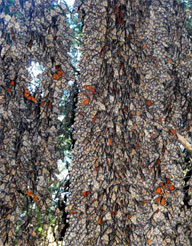The news for monarch butterflies can’t get much worse.
After reaching an all-time low at their Mexico wintering sites last year – occupying only 1.19 hectares – this year, monarchs hibernated on a mere 0.67 hectares (1.65 acres). Only 7% of Mexico’s monarch sanctuaries had butterflies in December – the largest, El Rosario, hosted most of the population.
Announced by World Wildlife Fund-Mexico in press conference today, scientists estimate the monarch population is down to 35 million and the possibility of rebounding is diminishing. At their peak in 1996, about a billion monarchs occupied nearly 45 acres of forest.
Monarchs literally cover the trees they winter on:

Extreme weather during the past wo years may be the cause of the precipitous decline – a difficult combination of heat and drought, wet and cold. Long term, the problem is vanishing habitat and the increased presence of GMO crops – which are wiping out their only host plant – milkweed.
This ubiquitous plant traditionally blanketed the Midwest – the Monarch’s biggest reproductive grounds. Even turning much of the land to farming over the last 200 years didn’t impede the Monarch, because milkweed (and other wildflowers) still grew along edges and even between rows of corn and other crops.
But in 1997, farming practices began to change and Monarch populations began to drop along with other pollinators, such as bees, which depend on native flowers.
That’s when Roundup-ready corn and soybeans entered the market. Since then, instead of tilling weeds, farmers spray entire fields with Roundup. And as insect resistance rises, they spray more and more. Of course, the spray itself kills butterflies and bees, and when they take nectar from GMO-plants.
During the upcoming breeding season, habitat protection in the US will be crucial.
The North American Monarch Conservation Plan is a science-based strategy to help the monarchs:
1) habitat restoration and enhancement
2) increasing milkweed on public and private lands
3) providing tools and guidelines to the public and relevant agencies to inform monarch conservation efforts.
Efforts include promoting carefully-designed mowing, burning, thinning, and harvesting regimes to restore ecosystem structure and species composition; increasing availability of milkweed seeds for large-scale planting; inclusion of biogeographically native milkweed and nectar plants in habitat restoration plantings; and seeding utility and roadside right-of-ways with native plants, including local milkweed species.
Learn more:

 Loading...
Loading...
This article is a bit thin when it comes to assigning responsibility for the cause of the problem. I would say that the cause is two-fold … Monsanto’s GMO corn and the heavy use of the herbicide, Roundup. Roundup was mentioned but what was missing is the fact that the Bt toxin from the GMO corn is also lethal to the Monarch caterpillar, and this fact would make any “habitat restoration or enhancement” impossible since the caterpillar cannot coexist anywhere near GMO crops that contain the Bt toxin. Take a look at this link to verify what I am saying … http://www.non-gmoreport.com/articles/july2011/GMcropsmonarchbutterflieshabitat.php